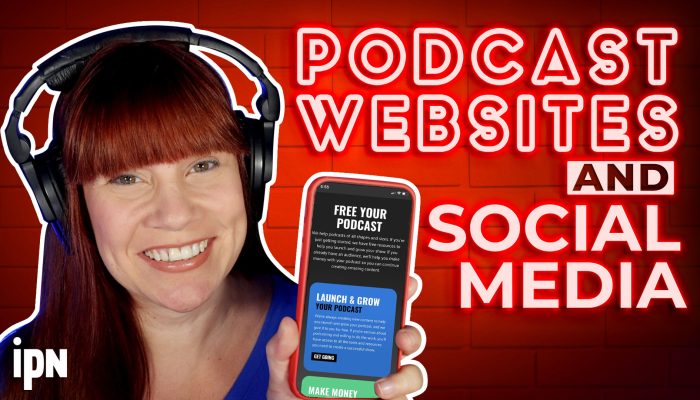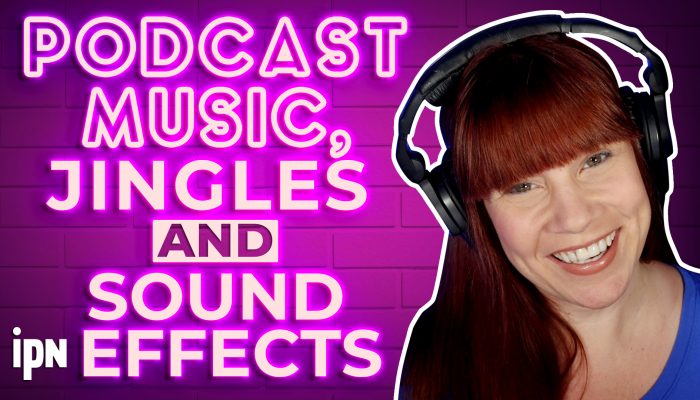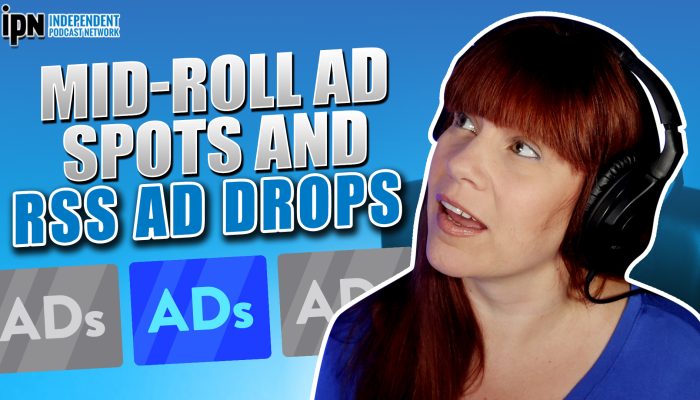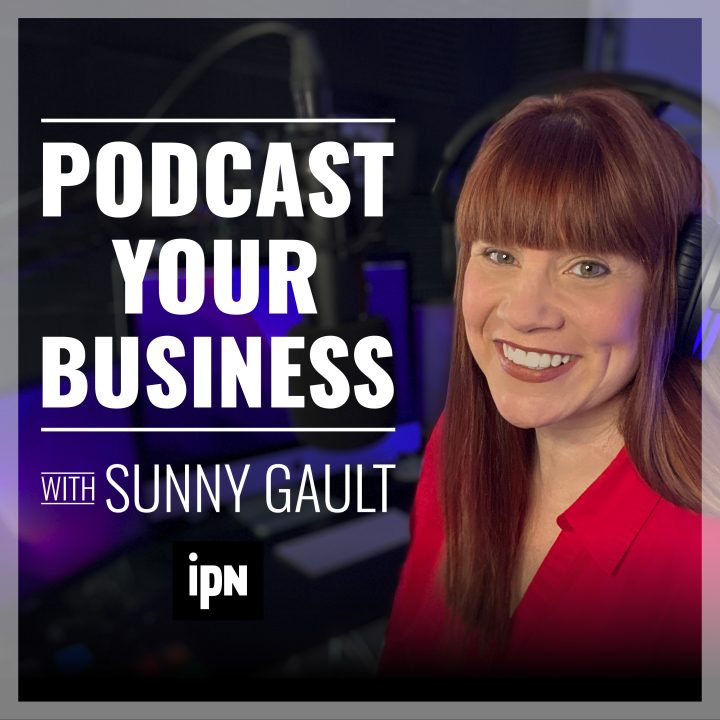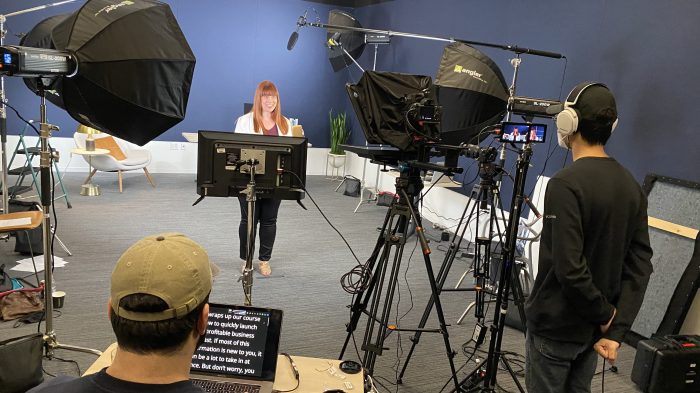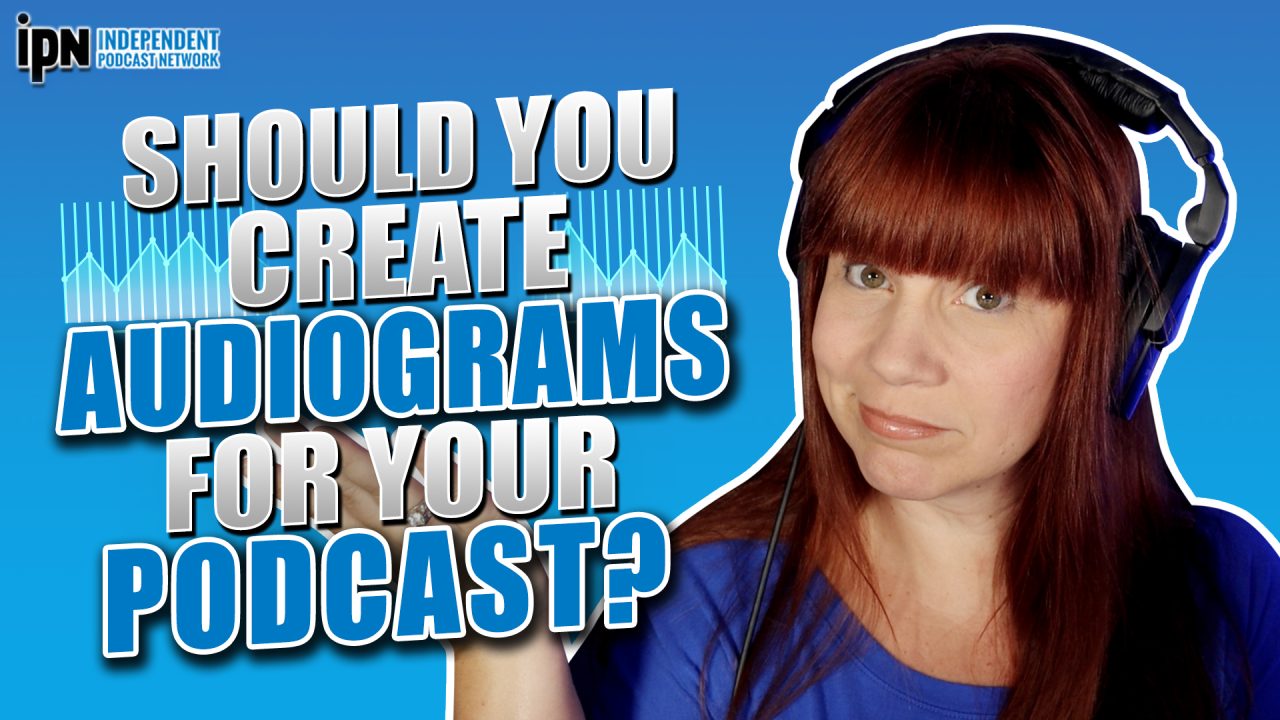
What’s your goal? Subscribers or simple engagement?
You just finished creating an amazing episode for your podcast- and now it’s time to tell the world about it. You could just grab a link and post it, but is that enough to make people click for more? Audiograms are one way of sharing a clip from your podcast with others. But, is it worth it? What does it take to create an audiogram and will it actually work for your podcast?
Here’s what we’re going to discuss…
- What is an audiogram?
- What is the purpose of an audiogram?
- How do you create audiograms?
- How do you know if audiograms are right for you?
What should you include in your podcast promo?
The guide breaks down things to consider when creating your podcast promo, as well as ways to use your promo to help grow your audience.

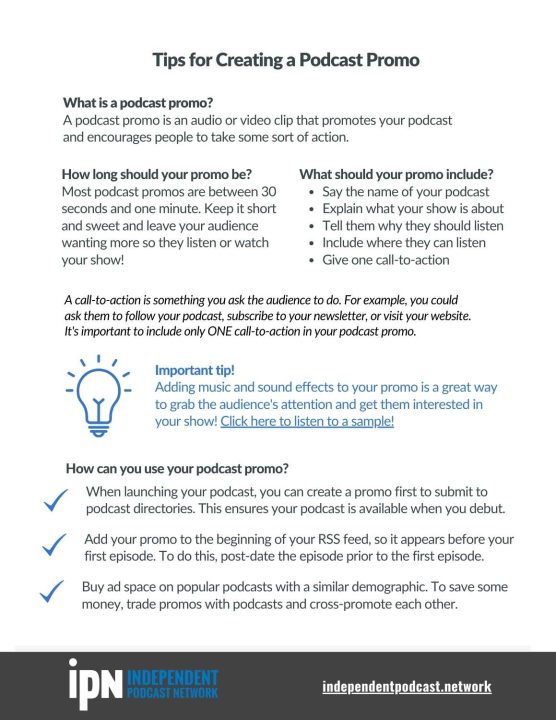
Episode Transcript
0:02
You just finished creating an amazing episode for your podcast. And now it’s time to tell the world about it. You could just grab a link and post it. But is that enough to make people click for more? Audio Graham’s are one way of sharing a clip from your podcast with others. But is it worth it? What does it take to create an audiogram? And will it actually work for your podcast? Take it away, mister radio man. Podcast Your Business.
0:38
Howdy everyone. Thanks so much for checking in and checking out today’s podcast episode. Welcome to Podcast Your Business. My name is Sunny Gault. I’m a podcast coach, I mentor podcasters and I have been podcasting for the last 17 years. I’m also the founder and CEO of a company called Independent Podcast Network (https://independentpodcast.network), we put out a ton of free content for podcasters. A lot of witches, you know how to create a podcast and what to do with your show and how to make it make it successful. And then when you get to the point where you really want to monetize your show, we work with you on a individual basis to get that funding that you need to be able to take your show to the next level. Today, I am here to help you create amazing podcasts. And we do focus more on podcasts that you’re creating for your business. But anyone that’s creating a podcast will benefit from today’s episode, we help you create these amazing shows by mastering the five P’s of podcasting. The five P’s are prep, plan, produce, promote, and profit. And I believe when you master these five Ps, so when you really know what you’re doing in these five sections, if you will, of podcasting, then you will have a successful show. And what we do on podcast your business is we pick one of these peas, and we talk about something that’s related to it and help you get better and better. So Mr. radio man, which of the five P’s are we talking about today? promote promote. Yeah, so as we are promoting our podcast, we need to have options, right. I’m not the type of person that says you just have to pick one option and stick with it. If you find something that works well for your audience, maybe that’s the way to go, depending on how many people you have helping you with your show, but audio grams, may be one of the promotional options that you check out, which is why we’re talking about this episode today. By the way, if you just try to Google audiograms…without the word podcast, you’re probably gonna see like a bunch of graphs and charts pop up because an audiogram as it doesn’t relate to podcasting. So outside of podcasting is a way to measure frequencies. It’s a graph or a chart to measure audible frequencies. So my recommendation is if you’re looking for anything related to audio, grams, add the word podcast to your search. And then you’ll probably find what you’re looking for. Alright, so today, as we talk about audio grams, there’s some different things we’re going to cover, we’re going to focus on what an audio gram is, which is not a chart. As we’re using it in today’s context, we’re going to talk about the purpose of an audiogram. So if you do choose to do this, what can you expect to get out of it? Like what’s the whole point, right? We’re going to talk about how to create audio grams. And we’ll give you some tips and tricks. I have done this in the past. And I’m going to let you know or give you some factors to really consider to determine if this is a good fit for you and your show. I don’t think audio grams are for everybody. So a little sneak peek there. But it can be helpful. It really depends on what you’re trying to do with it. Okay, and we’re gonna dive into all this right after this quick break.
3:59
All right, so what is an Audiogram? One of the challenges in producing podcasts and really focusing on the promotional side of podcasting… is how do you get the word out there about your show? There was a lot of visual mediums and there’s a lot of emphasis right now on visual content. And most podcasts are audio based. Yes, we do have video podcasts out there, perhaps or even working on a video podcast. But historically, podcasts have been audio. And the challenging thing is trying to promote your podcast on these platforms that are video based, right? Is anyone tried to promote their podcast or, you know, try to jump on the whole YouTube bandwagon there and you know, trying to learn people who are creating YouTube content, you know, whatever your expertise is, you know, it’s difficult to do. And so audio grams are a way to help bridge that gap. What they are are short videos that include audio and visual elements from your podcast. And that can mean different things. So the audio part that’s pretty easy to figure out, it’s a clip from your show. Alright, that’s it. And we’ll get into how you create these and things you should look for in just a second. But that’s just a clip. That’s it. Now, because it’s video, it’s not usually you talking or whatever, right? Because you don’t have that you recorded this as an audio podcast. So you have to combine images, maybe some text, animated elements, in order to make this interesting. So what a lot of people do is you’ll see I’m sure you’ve seen this before, it will be a clip from a show, you’ll see some waveforms, you know, or something that pulsates or something to grab your attention. So when people talk, you know, something on it changes, it’s usually not just a static image, because that’s very exciting. Especially when people are expecting to see video, video just captures people’s attention more. So we’re trying to capitalize off of what people are already looking for. And video is just more interesting. I’m sorry, that’s just kind of, you know, when you’re doing things on social media, anything that moves, is going to grab your attention. So waveforms progress bars, you know, words on the screen, that’s what we’re talking about here.
6:28
Now, what’s the purpose of an audiogram? The main purpose is to introduce your podcast through a single episode, to new listeners, you’re trying to promote this amazing episode you just created, how are people going to find out about it? You know, if people are already subscribing to your show, that’s great. It’ll pop up in their feed. But how else are you going to share a specific episode. And as I mentioned in the intro, you could copy a link, like, let’s say, your podcast episode is also on your website. And I did this for many, many years before audio grams were a thing, I would make sure for SEO purposes, that my podcast episode was available on my website, I had a unique URL or link to that episode. And I would copy that, and I would paste it in Facebook or Twitter or whatever. But that was really just going through the motions. Because I don’t think people were really listening. You know, just one more link, you know, and it takes a lot for someone to click on a link and do something with it. I know that sounds ridiculous. But we live in a day and age where if you have to do one extra click or step or whatever, that is a big deal. And so audio, grams minimize all of that, because they in theory will show up in your feed. And this is usually used with social media. I have seen it post on websites before but I don’t know if you’re already on a website, you’re probably going to listen to an episode, I don’t know, there may be use cases where that’s appropriate. But for the most part, you are trying to grab people that are on a different platform and give them a snippet of your show, and the hopes that they become interested. And a lot of those people are going to be new people, right? They haven’t heard of your show before. And you may also want to use this. And this is great for businesses. By the way. If you already have a group of people that you’re reaching out to let’s say you have like a Facebook group, or maybe a community on another platform. This is a great way to share little snippets of content to get your community that’s already interested in you and the information you put out there. So clients and customers things like that, to check out a particular episode. And perhaps even subscribe, that’s the best thing, guys, if you can get people to subscribe to your podcast doesn’t mean they’re gonna see everything. It doesn’t mean they’re gonna listen to everything. But that is definitely better than just getting someone to comment on your audio gram. And that’s kind of the downside of this is that, and I’ll get into some stats later on. But audiograms are great for kind of grabbing people’s attention. But then the question becomes, well, what do they do with that information? Because if someone’s just going to comment on your audiogram, that’s not getting you more subscribers or listeners or whatever it is that you’re trying to do. So we’ll talk about that more in just a little bit. But no, that is the purpose of the audiogram. Grab new listeners. Give them a little snippet because they are more likely if they hear you and like oh, that’s kind of interesting. That topic. I like their voice. I like their cadence. They seem really natural, right, you get a lot more information than just copying and posting a link to something.
10:09
All right, now let’s talk about how to create audiograms. There are specific platforms out there that specialize in this. And there are also ways to create audiograms from scratch. If you know, you know, if you have like an editing program, and you want to try to do all this on your own, I think that complicates things a lot. We are also seeing third party podcasting apps, add this as an additional piece of functionality to their platform. I’ll give you an example. I think you guys know that I’ve worked for Zencastr in the past, I worked with them for a few years. And one of the things they were developing, I’m not sure if they launched it yet, I left before this feature came out was the ability if you record with Zencastr, because they’re an online platform for recording with people remotely, then you could take that information you recorded through Zencastr, and be able to create an audiogram from it. So that’s an example of a podcasting platform that doesn’t specialize in audiograms using this technology, because it just kind of makes sense, right? You’re already recording through the platform, so why not be able to create an audiogram. So those are your options. There are specific audiogram programs. And that’s all they do. You can completely do this on your own. Or you can see if any of the tools you’re already using, tap into this in some way. And they’re all gonna have different features and things like that, I will tell you off the bat, that the app that I use, when I create audiograms, I’m just going to name drop here is headliner dot app, A-P-P. If you go to their website, you’ll learn more about them, you know, whatever one you choose to use is completely up to you. But they do have a free option. So you can start creating audiograms, see if it’s a good fit. And, you know, go from there. When you’re creating audiograms, I mean, how you do this is really dependent on the limitations of whatever platform you’re using, okay, but there are some standard things that I would recommend that you do. The first thing is, whatever your audiogram sounds like, looks like, I would pick some sort of format that’s recognizable, and that you stick with it, that does not mean that every audio gram has to look the same, obviously, the sound bites are going to change. But I’m talking about the overall look of it. I think one of the things that people do that can be kind of great is if you have guests on your show to be able to add the photo of your guest, whoever is talking in that soundbite maybe have a little photo, maybe that’s you, because you’re the host, maybe that’s also the person that you’re interviewing. So, you know, it needs to be visually interesting. Using photos, I say this, I say the same thing about creating artwork, using photos helps draw us in, because it’s not an inanimate object, it is a person. And even through a photo, we are connecting with your podcast more connecting with you if you are the host. So having your photo, as part of the visual, I think is a really good idea. I don’t recommend that you use a lot of text on the screen, maybe just the name of your podcast. And if you know, probably though, your name is in your logo somehow. So maybe you include that on there. But not a lot of other text. Depending on which platform you choose to do this. One of the features is to have the text of whatever is playing whatever you know, the soundbite is show up on the screen. It’s like remember those bouncy balls on TV like someone’s singing and follow the bouncy ball, you know do to do to do and our diagrams can do the same thing. There’s no bouncy ball usually, but they’ll have text up on the screen. And maybe what’s being said is more in bold. So it’s essentially the same thing you are following along with the text. And I can tell you with 100% certainty that that is going to get people to listen or watch if you will your audiogram longer if you have the text up there on the screen. In order to create these, they are going to have to transcribe at least part of whatever it is that you’re you know, whatever section of your episode that you’re going to use. I have to transcribe it. It’s kind of part of this.
14:40
You know, last week we talked about AI technology and it is using AI to help transcribe part of that because if you want to use the text, it has to be available. And you do have the ability usually to go in there again depending on the platform you’re using and adjust that because they may not get it exactly right and they may not understand all the words But if you’re talking about the overall image, I do like and I would encourage you to at least test out using the words because I think it draws people’s attention more and, and longer, I think they’re going to watch your audiogram longer if text is up on the screen. So let’s talk about what they’re actually listening to. There are audio gram systems out there platforms. And headliner is one of them, that will use AI technology to grab a sound bite for you. I’m going to be honest with you, as of recording this episode, I don’t trust that I’m sure I mean, the whole point behind AI, artificial intelligence is that it learns and grows, and it becomes better and better. So I’m going to reserve my opinion on future AI. But for now, I don’t think it’s strong enough. And if you’re going to go through this whole step by step process of creating an audiogram, the whole thing is about the sound bite. So I don’t recommend that you hand that off to an AI system. What I recommend that you do is as you’re recording your podcast episode, that you listen for what I call the aha moments. Is there something that even caught you by surprise, when you were recording your episode, start to listen to the soundbites, as you’re recording. Listen for these aha moments, even write down the timecode. Because if you’re recording, usually, you know, you know how long you’ve been recording for just jot down the time. So that if you are an assistant or someone who’s going to go create an audiogram, that you have an idea of something that you can use. In general, you want to leave your audience wanting more, this is marketing 101, okay. And you want them to be like, Oh, I have to listen to this episode, I have to find out what happened. It’s kind of hard to do sometimes. But in general, don’t just give them everything, cut it off at a crucial moment that they want to take some sort of action. So that’s typically what an audio gram is, it’s usually just one soundbite.
17:18
I have also seen audiograms that provide a quick summary of what the entire episode was about. So that’s probably going to be a longer clip, if you will. And, and for something like that, you really do need to edit the sound separately, and then upload the whole thing to whatever audio program you’re using. So there’s that, you can also create a compilation of interesting moments. And I don’t know anyone that’s doing this just for one episode, that’s a lot of work. But you could create like a little highlight reel for your entire podcast, and pick different sound bites with different guests and you know, do something like that. Or maybe you do that like for a whole season. Hey, check out season two. Here. You know, here’s a compilation of some of the great things we discussed on season two. So you can use this in different ways. But most of the time it is to promote a individual episode for your podcast. How long should it be? Well, if we’re talking about just a soundbite for your podcast, my recommendation is that you limit it to 60 seconds or less. Sometimes that’s hard to do. That’s not a lot of time. So it’s okay to go a little bit longer, you also need to be mindful of what platform you’re going to put this on. Because if you’re creating this for YouTube short, it’s not going to let you go longer than 60 seconds. So you have to know in advance. And I know headliner does this perhaps some of the other audiogram platforms do this as well. But it will really guide you through the whole process. So it will start out by saying what platform do you plan to use this on, and then you click it’s a YouTube shorts. And then we’ll walk you through all of that not only will it change the dimension and the sizes for your audiogram, which is important, because you don’t want like a square image, you know, going out on Twitter, like you know, the format has to be correct. But it will also guide you as far as length and things like that. So again, just one more, you know, tip if you’re going to use a platform, they do a lot of this little stuff for you that you may not think of right away. One of the big features that I use is that I don’t have to upload a separate clip like I don’t have to edit a separate clip, I will just go and I’ll say pull from my RSS feed. So I select whatever episode it transcribes it actually before it transcribes it. It asks me to select the content that I want to use in the audiogram. So I’ll do like an in and out point, they’ll give you kind of like a timeline. And I’ll do an in and out point, hit save or hit next something Unlike that, and then it will create a transcript from whatever I have selected. And then I go through, I can modify that all that kind of stuff. And they usually do have templates for you. So you know, when I was talking about the images and stuff like that, you’re like, Oh, that’s a lot, I’m not a graphic designer, these programs usually have a bunch of different templates you could choose from. So you know, just start there, you know, you can always modify it later, grow, do all that kind of stuff. And they will also save a template for you, you may have to upgrade to a paid version for that to happen. But once you kind of get the flow of this, it’s pretty easy.
20:39
Okay. So now let’s talk about are audiograms, right for you? Obviously, only you can make that decision. But if I were making this decision, here are some of the things that I would consider. How often are you using social media? Is that a driving tool for you? Are you investing time into that to help promote your podcast, if you already have social media set up for your business, and your podcast is just one more facet of you, outreaching and marketing and promoting your business, that I think that could make sense, right? Again, if people are following your page, or whatever they’re already interested in you. So having a clip from your most recent episode that goes out to those people, obviously, you are at the mercy of the algorithms here. But in general, I think that could probably work to get more of your audience to actually listen to your podcast, you have to think also about the time and money that it’s going to cost you to create these audio grams. Like I said, headliner does have a free version, it does not have all the bells and whistles. So you need to check that out for yourself a lot of the automation, you don’t get that with the free version. And it limits you to a certain amount of audio grams per month. So you have to consider the cost for the program, which I think for headliner, at least right now to get all their bells and whistles is about 20 bucks a month, okay. And then there’s, you know, smaller plans as well. Or maybe you have an assistant or someone helping you with this, that is going to go through the process. Maybe they are using a platform like headliner. And it’s still you know, you’re still paying them to put this kind of stuff together. So think about the time and money to create all of this. And then the big question is, does it really work? Do audiograms really work for your podcast? And I would say, it depends on what your goal is. Are you trying to get people to subscribe to your podcast, if that is your goal, or listen on a regular basis. If that is your goal, I would say I think audiograms are a good tool, I think it’s going to be very hard to measure. People actually making that connection and subscribing to your show, I don’t even know how you would get those numbers. Because you have to understand, if you are promoting content on social media, you have to understand the mindset of the people that are consuming the content, they are on that platform to scroll. And yes, your video may attract their attention. And that’s great. So they may listen for a minute. This is why I say only do a minute because people’s attention spans, you gotta you gotta do this quick. But are they going to take action? Because a lot of these audiogram programs will allow you to click a button and whatever, you know, subscribe, do whatever. Are they going to do that? Because they’re in the process of scrolling? I know it sounds ridiculous, but most people won’t. Unless you just blew them out of the water. You know, and that’s kind of hard to do sometimes. So if your goal is to get people to subscribe to your show, it’s not impossible, I don’t think you’re gonna see the numbers right away, you’re not going to see a huge jump right away. But if you do this over time, and you create a lot of compelling content, it is possible.
24:00
Now what numbers do we actually have to back audio grams? In other words, why are podcasters doing this if there’s no real benefit, if we can’t really track this kind of stuff. So WNYC was, at least they’re credited with being one of the first big groups or networks, if you will, to use audio grams. And they did their own little test on this. And they found that when they pushed audio grams, as opposed to just providing a link that goes back to their, you know, podcast page or whatever, that on Twitter, the average engagement was eight times higher. And they did the same thing on Facebook, and they found that the engagement was 58% to 83% Higher. Now, let me give you another stat headliner. So headliner dot app, they’ve obviously done some of their own studies as well. They found that when they shared a post on Facebook, and they did it two different ways they did The static like a static image, maybe like your podcast artwork with a link, and hey, today’s episode, this is what we’re talking about. And then they did an audiogram. They found that the audio gram generated five times the amount of traffic. So here’s the thing, though, when we talk about engagement and traffic, what does that what does that really mean? Because someone can engage with your audiogram, simply by liking it by commenting it, but never take another step from there. And that’s why personally for me, I don’t invest a lot of time in audio grabs, I have not seen the benefit of really getting people to subscribe to the podcast, you know, to come back multiple times. I am not a social media person. In fact, of the independent Podcast Network, my company, I recently just created a Instagram page for it. Because Because my assistant really wanted to have it, I, I don’t really care for it. I’m not on social media, it is not my thing, I have wiped it out of my marketing strategy. So for me, I look at this and I’m like, well, maybe we could promote different things, but it’s just not very high on my list of priorities. Now, if you happen to have a good marketing budget, and you don’t have to pick and choose, and everything is well funded, why wouldn’t you do this, it’s one more way for people to find your content, it certainly can’t hurt your podcast. So if you can, you know, find an ebb and a flow and financially, it makes sense. I think that’s great. Use it, it’s one more tool in your arsenal. And like I said, I don’t necessarily think promotion for podcast is a one size fits all kind of situation, I think you need to have multiple ways that you’re getting your content out there if you can do that. But for those of you who are just starting your podcast, you’re trying to figure things out. If you are already investing time into social media, I would say give it a go. There are programs like Headliner that will allow you to try this out for free and then see how people respond. Maybe there are additional benefits to this that aren’t even really connected to your podcast. For example, if you’re doing this for your business, let’s say you already have a social media page for your business, you are creating an audiogram and putting it out there. Maybe it attracts people that have no idea how to listen to podcasts are not that interested. But something you know, they really liked what you said about something, and they reach out and they say, Oh, I didn’t even know that you focus on that. Can we set up an appointment or a call? Because I’d really like for you to help me with that. Okay, then that just helps you get another client. So think about this in a multifaceted approach. Is it going to directly lead to more subscribers? I’m not seeing it right now. If that does happen, it’s over a period of time. It’s really hard to track. Can it get engagement up? Yeah, I think it absolutely can. So it really depends on what your goal is here for the audiogram. If you are specifically interested in promoting your podcast, I have always said the best thing to do is to swap promos with other podcasters because playing your promo on their show and vice versa. That is exposing both audiences to the podcast. They’re already in podcast mode, and they’re more likely to click a button or do whatever, because they’re already podcasters. Okay, so that would be my if you had to pick one thing I still think swapping promos is better. We’re gonna take a quick break and when we come back, we’ve got a freebie for you that is related to promos will be right back.
28:57
As we’ve been talking about today, promoting your podcast is really important. And there are many different ways that you can do that. My main way that I use to promote my podcast is by cross promoting with other podcasts. I have a free download for you guys that talks about how to produce your own promo. And I would recommend that if you don’t already have a short audio promo for your podcast that you create this and if you want more information on that I will include the link for this free download in the description below. Write for this episode. And you don’t even have to give me your email for it click on the link download it and I hope it helps your show. And we have a lot more free resources on our website you want to check it out https://independentpodcast.network. We have weekly blog posts that come out more podcast episodes like this one. I do videos I do special handouts. And if you are new to podcasting, we’ve got several courses that you can take absolutely free they’re all video courses, and you can pick and choose what videos you want to watch. It’s all on the website. If you’re interested in dynamic ad insertion. I recently created a course about that that’s going very, very well. We’re getting a lot of great compliments on that. All of it is free on our website. So I hope it helps you guys out. Until next week. Remember, you should start a podcast!





